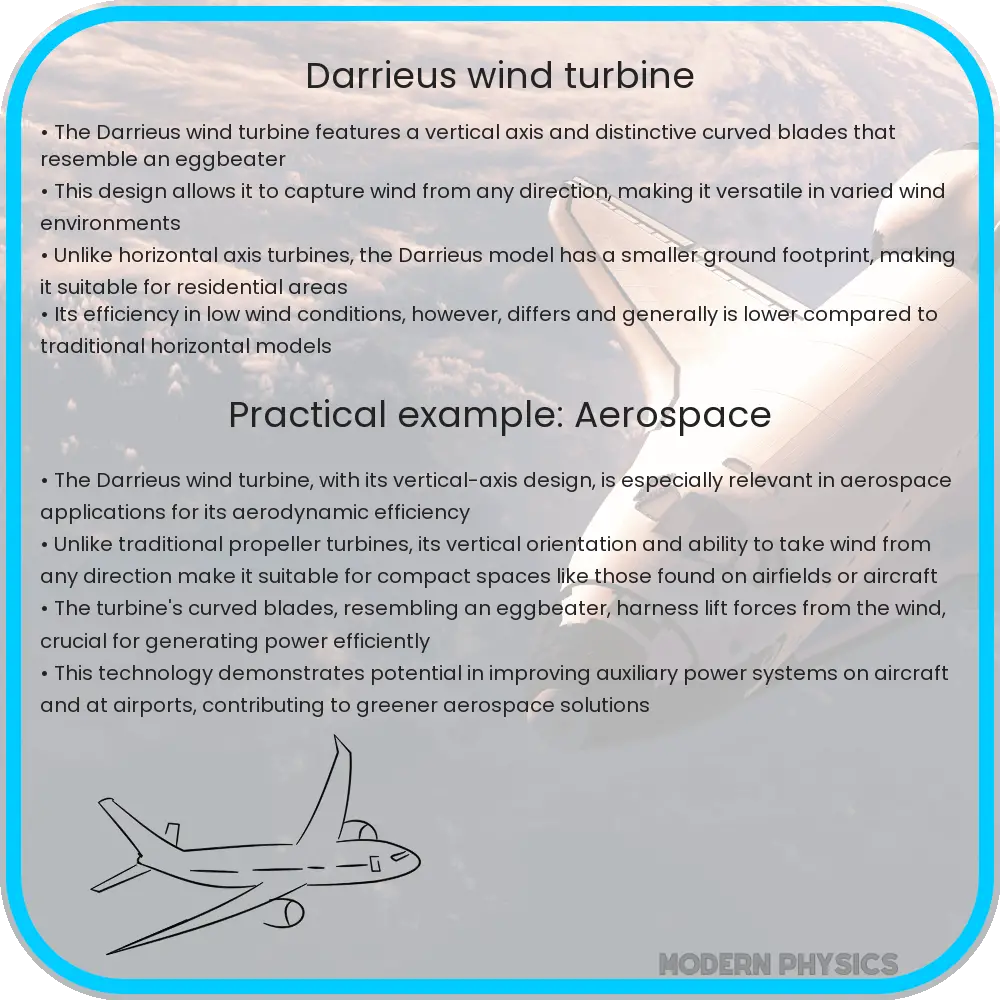Overview of the Darrieus wind turbine, a vertical-axis turbine with unique efficiency and design, optimizing wind energy capture from variable patterns.

Darrieus Wind Turbine: An Overview
The Darrieus wind turbine, often recognized by its distinctive vertical axis and curved blades, offers a unique approach to harnessing wind energy. Named after the French engineer Georges Darrieus who patented the design in 1931, this type of turbine functions differently from the more common horizontal-axis wind turbines (HAWTs). In this article, we’ll explore the efficiency, aerodynamic design, and hydrodynamic aspects of Darrieus wind turbines.
Understanding the Darrieus Wind Turbine
Unlike horizontal-axis turbines that align with the wind, Darrieus models utilize a vertical axis. This design allows them to capture wind from any direction, making them particularly useful in areas where wind patterns are highly variable. The most recognizable form of the Darrieus turbine features curved blades that resemble a troposkein shape — akin to the strands of a DNA helix — and rotate around a vertical shaft.
Efficiency of Darrieus Wind Turbines
The efficiency of wind turbines is often measured by their coefficient of performance (Cp), which compares the actual power generated to the power available in the wind. The theoretical maximum Cp for any wind turbine, known as the Betz Limit, is approximately 59.3%. While traditional horizontal-axis turbines can approach this limit under optimal conditions, Darrieus turbines typically achieve lower Cp values. This is partially due to the complex aerodynamics involved as each blade moves through the wind at varying angles during each rotation, causing dynamic changes in lift and drag.
Aerodynamic Design
The aerodynamic design of Darrieus turbines is critical for maximizing their performance and efficiency. The shape of the blades and their configuration around the vertical shaft significantly influence the turbine’s ability to convert wind energy into mechanical power. The curved, troposkein shape of most Darrieus blades helps in maintaining a consistent rotational speed and smooth operation across different wind conditions.
The lift-based operation of these turbines allows them to generate torque at the shaft. However, the variation in angular velocity and angle of attack as the blades rotate can lead to aerodynamic inefficiencies, such as cyclic variations in lift force. These variations need careful consideration during the design phase to optimize performance and minimize mechanical stresses.
Hydrodynamics in Darrieus Turbines
Although primarily discussed in the context of wind, the principles of hydrodynamics also apply to Darrieus turbines when they are utilized for capturing energy from water currents, known as hydrokinetic energy. In these applications, Darrieus turbines must be adapted for operation in fluid mediums substantially denser than air, which necessitates robust structural designs and efficient blade profiles to effectively exploit water currents.
The hydrodynamic efficiency in these turbines depends significantly on their ability to minimize drag while maximizing lift in a denser medium. Similar to their aerodynamic counterparts, the hydrodynamic performance can be defined by the lift-to-drag ratio, a critical factor in determining the overall efficiency of turbines in aquatic environments.
Deployment and Environmental Impact
One of the advantages of Darrieus wind turbines is their minimal environmental footprint, particularly in comparison to traditional horizontal-axis turbines. Their vertical design allows for a smaller ground space requirement, which can be particularly beneficial in urban or densely populated areas. Additionally, Darrieus turbines produce less noise, a significant factor when considering their use in residential zones.
Furthermore, the vertical axis design does not pose a significant threat to avian species. Birds are more likely to avoid these structures than the horizontally oriented blades of traditional turbines, which can blend into the sky at certain speeds and angles, making them hazardous to birds in flight.
Maintenance and Longevity
Maintaining Darrieus turbines involves standard checks and balances. Given their unique structure and operation, specialists often focus on the integrity of the blades and the central shaft. Regular maintenance ensures that the turbines perform efficiently and can extend their operational life significantly. The design allows for easier access to components compared to horizontal-axis turbines, where the main operational mechanisms are typically situated high off the ground.
However, the longevity of these turbines can be affected by material fatigue due to the constant variation in forces experienced by the blades. Advanced materials and innovative engineering designs are continuously being developed to address these challenges, aiming to enhance the durability and reliability of Darrieus turbines.
Future Prospects and Technological Innovations
Technological advancements continue to expand the capabilities and applications of Darrieus wind turbines. Researchers are exploring innovations such as adaptive blade designs that can change shape in response to wind speeds and directions, thus optimizing performance. There is also a growing interest in integrating smart technologies that utilize sensors and artificial intelligence to predict maintenance needs and operational adjustments in real-time.
With the global shift towards renewable energy sources, Darrieus wind turbines offer significant potential due to their versatility and adaptability. These turbines are not only suitable for wind energy generation but also for hydrokinetic applications, making them a valuable component of the renewable energy mix.
Conclusion
Darrieus wind turbines stand out as an innovative solution in the renewable energy sector. With their unique aerodynamic and hydrodynamic properties, minimal environmental impact, and adaptability to various environments, they hold the promise of playing a crucial role in the sustainable energy future. As technology advances and environmental considerations become even more pressing, the Darrieus turbine’s potential in both wind and water applications seems increasingly promising. Their ongoing development and improvement will likely continue to make them a fascinating subject of study and an important option for global energy strategies.
